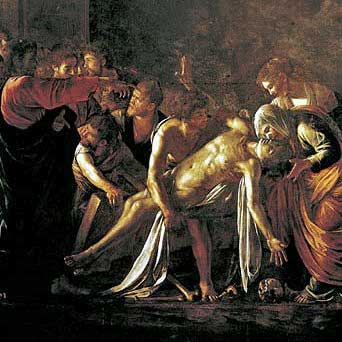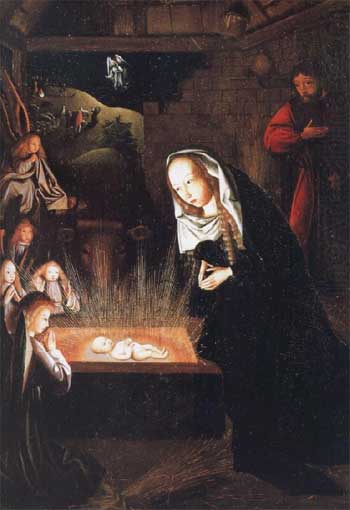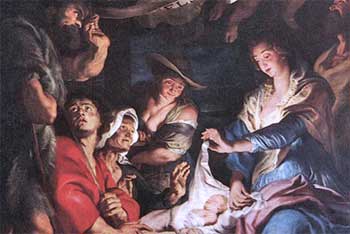
Then the righteous will answer him, saying, “Lord, when did we see you hungry and feed you, or thirsty and give you drink? And when did we see you a stranger and welcome you, or naked and clothe you? And when did we see you sick or in prison and visit you?” And the King will answer them, “Truly, I say to you, as you did it to one of the least of these my brothers, you did it to me”
Matt 25:37-40
Most people assume that the author of Matt 25:37-40 was teaching universal love for children, the poor, etc., based on a love of Jesus. However the author of Matt 25 had first century concerns in mind, apocalyptic concerns, and was thinking less about everyone loving each other indiscriminately and more about what the world owed the followers of Jesus who were attempting to spread the message to repent because the kingdom of God and Son of Man was coming soon. The “little ones” or “least of these” were the disciples Jesus had sent out to preach a soon coming apocalypse:
Matthew 10:42 New International Version
And if anyone gives even a cup of cold water to one of these little ones Who Is My Disciple, truly I tell you, that person will certainly not lose their reward.
Matthew 18:6 New International Version
If anyone causes one of these little ones—those who believe in me—to stumble, it would be better for them to have a large millstone hung around their neck and to be drowned in the depths of the sea.
Matthew 18:10 New International Version
See that you do not despise one of these little ones. For I tell you that their angels in heaven always see the face of my Father in heaven.
Matthew 25:40 New International Version
The King will reply, ‘Truly I tell you, whatever you did for one of the least of these Brothers And Sisters Of Mine, you did for me.’
If you mistreat the missionaries whom Jesus sent out youʼll be judged negatively by God. Theologian A. J. Mattill Jr., himself a universalist minister, pointed this out in his paper, “What the world owes the church: A breakthrough in the understanding of the parable of the sheep and the goats,” The Homiletic and Pastoral Review 71 (April 1971) 8-17. I have a copy of Mattillʼs paper but include a condensed description below from New Testament Abstracts, Vol. 15, #861 :
The parable of the sheep and goats (Matt. 25:31-46), which may be regarded as a midrash on Matthew 10:40-42; 18:5; and 16:27, is about what the world owes the disciples and/or the church. People are judged by the king on the basis of how they have treated the lordʼs missionaries. Those who have not received the disciples hospitably are condemned, for they have not done it unto the Lord (25:45,46). Those who have given food, drink, and clothing to the missionary disciples, those who have visited the disciples when they were sick and in prison, will be declared righteous (25:37) and will inherit the kingdom prepared for them (25:34).
Hospitality to the disciples is hospitality to Jesus: “He who receives you receives me, and he who receives me receives him who sent me” (10:40). This theme repeats itself in 25:35-40: “As you did it to one of the least of these my brethren you did it to me” (25:40). Thus in both discourse and parable Jesus expresses the close ontological union between himself and his church (cf. Acts 9:4). This dwelling of the believer in Christ and of Christ in the believer is forcefully stated in Matthew 10:32: “Every one therefore who shall confess in me before men, in him will I also confess my Father who is in heaven” (American Standard Version, margin).
Hospitality to disciples will be rewarded on the day of judgment: In 10:41, 42 there are three references to the reward of eternal life granted in the judgment to those who were kind to Jesusʼ messengers, a reward granted by Jesus himself (10:32). Similarly, in the Great Assize the righteous will go away into eternal life (25:32-40, 46b), as directed by the Son of Man (25:34).
Inhospitality to disciples will be punished on the day of judgment: The fate of those Jews inhospitable to the missionaries is even worse than the fiery destruction of Sodom and Gomorrah (10:14, 15). Jesus himself will repudiate them (10:33). Jesus also warns his agents not to “fear those who kill the body but cannot kill the soul; rather fear him who can destroy both soul and body in hell” (10:28). Likewise in the parable those not hospitable to the disciples are condemned (25:32, 33, 41-46a), and the Son of Man says: “Depart from me, you cursed, into the eternal fire prepared for the devil and his angels; for I was hungry and you gave me no food …” (25:41,42).
Hospitality to the disciples is expected from the world: The twelve are to take no gold, nor silver, nor copper, nor a staff (10:9,10) but, being on a house-to-house mission, are to be absolutely dependent upon the hospitality of the people along their journey, living with those who are worthy (10:11-13). Note, too, the stress in 10:40-42 upon receiving the twelve, prophets, righteous men, and disciples. The parable presupposes this same receptivity by the populace: “I was a stranger and you welcomed me” (25:35).
Hospitality to hungry disciples is demonstrated by giving them food to eat: Jesus advised his disciples that “the laborer deserves his food” (10:10). It is precisely the same in the parable: “I was hungry and you gave me food” (25:35).
Hospitality to thirsty disciples is demonstrated by giving them water to drink: “And whoever gives to one of these little ones even a cup of cold water because he is a disciple, truly, I say to you, he shall not lose his reward” (10:42). This promise points directly to 25:35: “I was thirsty and you gave me drink.”
Hospitality to ill-clad disciples is demonstrated by giving them clothes to wear: The twelve proceed with no shoes and without a change of undergarments (10:10), so necessary for cleanliness in a hot climate, and thus will soon need clothing from friends, even apart from persecution. This need is also reflected in the parable: “I was naked and you clothed me” (25:36).
Also note this more recent paper in Novum Testamentum
Abstract
The Matthean community consists of two groups which are symbolized by “sheep” and “goats” respectively. In Matt. 25:31-46 the “least of these” are not the poor in general, but those who are in the mission fields sent out by the Matthean community. Determining that the unsuccessful result of the missionary works was due to the insufficient support from the community, Matthew attempts to elicit a strong concern among them. Hence, the Matthean Jesus, who identifies with the missionary team at the brink of collapse, encourages the sheep group to maximize its ongoing support for the least, and warns the goats group not to be indifferent to them.
Source: Das Weltgericht und die Matthäische Gemeinde by Joong Suk Suh, Novum Testamentum, Brill Academic Publishers, Volume 48, Number 3 / June, 2006, Pages 217-233
To put the above in its wider apocalyptic context, note that Jesusʼ plea for “moral perfectionism” directly resulted from his mistaken belief that Godʼs judgment day was imminent, as pointed out by Robert M. Price:
Jesusʼ eschatology accounts for the radical perfectionism of the application of his values, e.g., “Love your enemies…bless those who curse you…if struck on one cheek, turn the other…lay not up for yourself treasure on earth [do not save money!]…Whoever takes away your coat, do not withhold your shirt from him either [leaving you naked, since those two items summed up the clothing worn by ancient Near Easterners]…give to everyone who asks of you, and whoever takes away what is yours, do not demand it back [!], etc.” I canʼt buy Lutherʼs way out, i.e., that Jesus was showing us how we canʼt obey these values, in order to prepare us for the gospel of justification by faith! Sorry, Luther! The text repeatedly says, “Do this to reach the kingdom, do this or be punished.” I am thinking foremost of the Sermon on the Mount in which Jesus is depicted as saying:
In everything, therefore, treat people the same way you want them to treat you, for this is the Law and the Prophets … Beware of the false prophets, who come to you in sheepʼs clothing, but inwardly are ravenous wolves. You will know them by their fruits … Every tree that does not bear good fruit is cut down and thrown into the fire [apocalyptic speech]. So then, you will know them by their fruits. Not everyone who says to Me, “‘Lord, Lord,’ will enter the kingdom of heaven, but he who does the will of My Father who is in heaven will enter. Many will say to Me on that day, “Lord, Lord, did we not prophesy in Your name, and in Your name cast out demons, and in Your name perform many miracles?’” And then I will declare to them, “I never knew you; Depart From Me, You Who Practice Lawlessness.” Therefore everyone who hears these words of Mine and acts on them, may be compared to a wise man who built his house on the rock. And the rain fell, and the floods came, and the winds blew and slammed against that house [apocalyptic speech]; and yet it did not fall, for it had been founded on the rock. Everyone who hears these words of Mine and does not act on them, will be like a foolish man who built his house on the sand. The rain fell, and the floods came, and the winds blew and slammed against that house; and it fell and great was its fall. [Matt. 7: 12-27]
Most perfectionists are neurotics: was Jesus? Not if he predicated perfectionism as the only way to live due to the nearness of Godʼs judgment day! Then it would seem feasible!
Robert Green Ingersoll (1833-1899), a preacherʼs son who grew to become Americaʼs greatest freethinker, reached a similar conclusion:
That generation [of Jesusʼ day] was not to pass away until the heavens should be rolled up as a scroll, and until the earth should melt with fervent heat… Filled with the thought of coming change, he [Jesus] insisted that there was but one important thing, and that was for each man to save his soul. He should care nothing for wife or child or property, in the shadow of the coming disaster…He endeavored, as it is said, to induce men to desert all they had, to let the dead bury the dead, and follow him. We know now - if we know anything that Jesus was mistaken about the coming of the end, and we know now that he was greatly controlled in his ideas of life, by that mistake. Believing that the end was near, he said, “Take no thought for the morrow, what ye shall eat or what ye shall drink or wherewithal ye shall be clothed.” It was in view of the destruction of the world that he called the attention of his disciples to the lily that toiled not and yet excelled Solomon in the glory of his raiment. [The parable even has an appropriately apocalyptic ending: “The grass of the field that is alive today and tomorrow is thrown into the furnace!” Mat 6:30] Having made this mistake, having acted upon it, certainly we cannot now say that he was perfect in knowledge.
For more on all the false predictions found throughout the New Testament of a soon coming Son of Man, or the Lord, see The Lowdown on Godʼs Showdown.
Another Often Misinterpreted Gospel is John. Is it Primarily About How Much Christians Should Love Outsiders? Neighbors, Enemies? Or Does It Focus on In-Group Love of Believer for Believer?
The Gospel of John consists of “anti-language” say Social Scientists. It is not a Gospel about “loving oneʼs neighbor/enemies,” and in fact mentions neither. Instead it is about indoctrination, or in the idiom of cults, “love bombing,” and maintaining in-group thinking.





